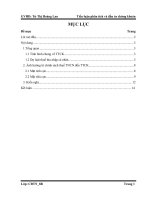Chương 5 Ảnh hưởng của giá cả và thu nhập về số lượng nhu cầu pptx
Bạn đang xem bản rút gọn của tài liệu. Xem và tải ngay bản đầy đủ của tài liệu tại đây (107.06 KB, 15 trang )
Chapter 5
The effect of price and income
on demand quantities
David Begg, Stanley Fischer and Rudiger Dornbusch, Economics,
6th Edition, McGraw-Hill, 2000
Power Point presentation by Peter Smith
5.2
The price elasticity of demand
…measures the sensitivity of the quantity
demanded of a good to a change in its price
It is defined as:
% change in quantity demanded
% change in price
5.3
Elastic demand
■
ELASTIC demand
–
when the price elasticity is more
negative than -1
–
i.e. when the % change in quantity
demanded exceeds the change in price
➡
e.g. if quantity demanded falls by 7% in
response to a 5% increase in price
➡
elasticity is -7 ÷ 5 = -1.4
5.4
Inelastic demand
■
INELASTIC demand
–
when the price elasticity lies between -1
and 0
–
i.e. when the % change in quantity
demanded is smaller than the change in
price
➡
e.g. if quantity demanded falls by 3.5% in
response to a 5% increase in price
➡
elasticity is - 3.5 ÷ 5 = - 0.7
5.5
Unit elastic demand
■
UNIT ELASTIC demand
–
when the price elasticity is exactly -1
–
i.e. when the % change in quantity
demanded is equal to the change in
price
➡
e.g. if quantity demanded falls by 5% in
response to a 5% increase in price
➡
elasticity is - 5 ÷ 5 = - 1
5.6
Price elasticity
for a linear demand curve
The price elasticity varies along the length of a
straight-line demand curve.
Demand
Unit elasticity
Elastic
Inelastic
Quantity
P
r
i
c
e
5.7
What determines the price elasticity?
■
The ease with which consumers can
substitute another good.
■
EXAMPLE:
–
consumers can readily substitute one brand of
detergent for another if the price rises
–
so we expect demand to be elastic
–
but if all detergent prices rise, the consumer
cannot switch
–
so we expect demand to be inelastic
5.8
Elasticity is higher in the long run
■
In the short run, consumers may not
be able (or ready) to adjust their
pattern of expenditure.
■
If price changes persist, consumers
are more likely to adjust.
■
Demand thus tends to be
–
more elastic in the long run
–
but relatively inelastic in the short run.
5.9
Elasticity and revenue
When price is changed, the impact on a firm’s total
revenue (TR) will depend upon the price elasticity of
demand.
For a price
increase
For a price
decrease
Demand is
elastic
TR
decreases
TR
increases
Demand is
unit elastic
TR does
not change
TR does
not change
Demand is
inelastic
TR
increases
TR
decreases
5.10
Elasticity and tube fares
■
Passengers can use buses, taxis, cars etc
–
so demand may be elastic (e.g. - 1.4)
–
and an increase in fares will reduce the number
of journeys demanded and total spending
■
If passengers do not have travel options
–
demand may be inelastic (e.g. - 0.7)
–
so raising fares will have less effect on
journeys demanded
–
and revenue will improve
How should tube fares be changed to increase revenues?
5.11
The cross price elasticity of demand
The cross price elasticity of demand for good i
with respect to the price of good j is :
% change in quantity demanded of good i
% change in the price of good j
This may be positive or negative
The cross price elasticity tends to be negative
if two goods are substitutes: e.g. tea and coffee
The cross price elasticity tends to be positive
if two goods are complements e.g. tea and milk.
5.12
Price elasticities in the UK
with respect to a 1%
price change in:
Food
Clothing Transport
Percentage change in
the quantity demanded of
Food
Clothing and footwear
Travel and
communications
0 0.1
0.1
0.3
–0.4
–0.5
–0.5–0.1
–0.1
5.13
The income elasticity of demand
The income elasticity of demand measures
the sensitivity of quantity demanded to a
change in income:
% change in quantity demanded of a good
% change in consumer income
The income elasticity may be positive or
negative.
5.14
Normal and inferior goods
■
A NORMAL GOOD has a positive income elasticity of
demand
–
an increase in income leads to an increase in the quantity
demanded
➡
e.g. dairy produce
■
An INFERIOR GOOD has a negative income elasticity of
demand
–
an increase in income leads to a fall in quantity demanded
➡
e.g. coal
■
A LUXURY GOOD has an income elasticity of demand
greater than 1
➡
e.g. wine
5.15
Income and the demand curve
For an increase in income:
Quantity
P
r
i
c
e
D
0
NORMAL GOOD
INFERIOR GOOD
Quantity
D
0
P
r
i
c
e
D
1
Demand curve
moves to the right
D
1
Demand curve
moves to the left









